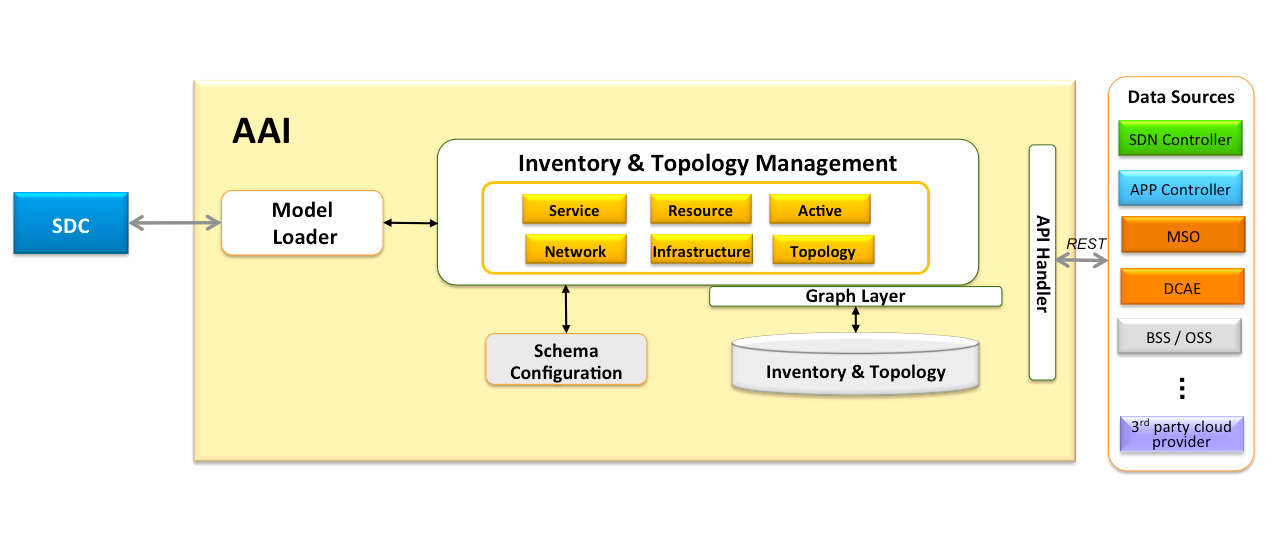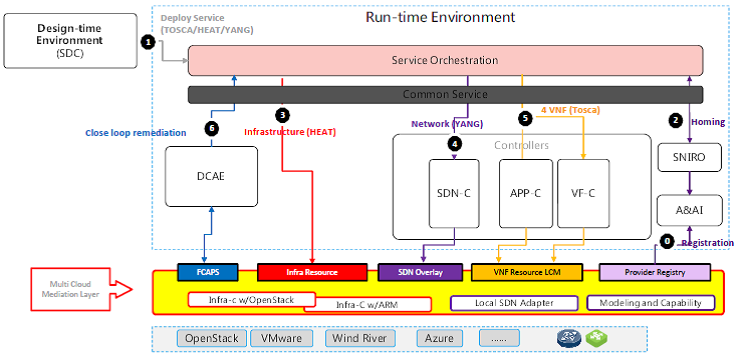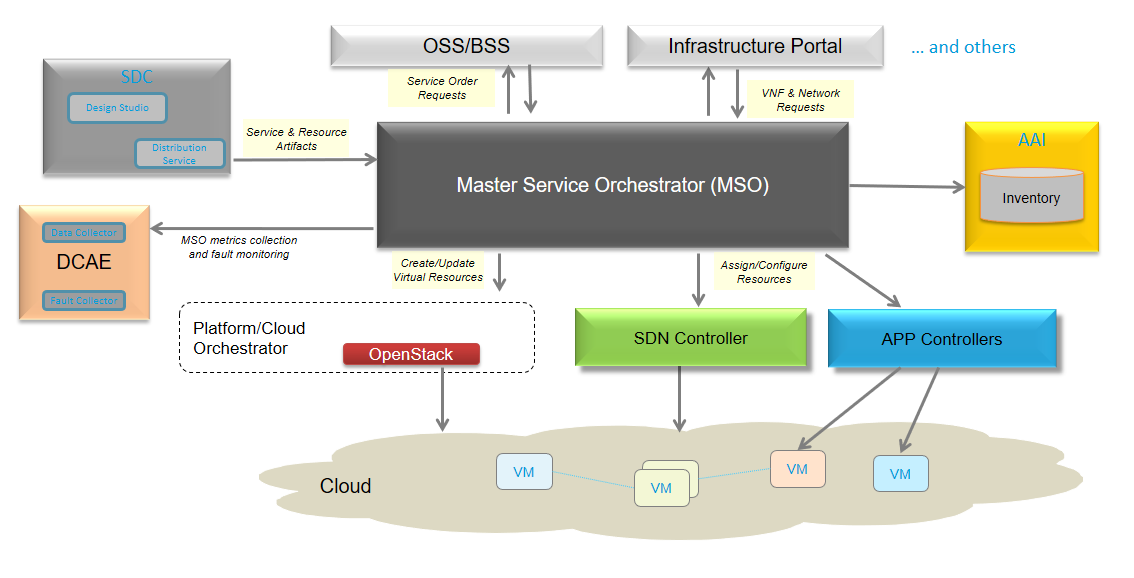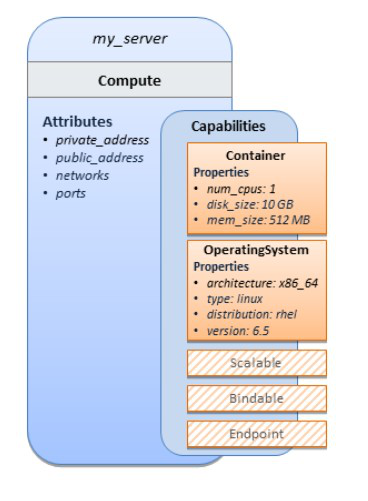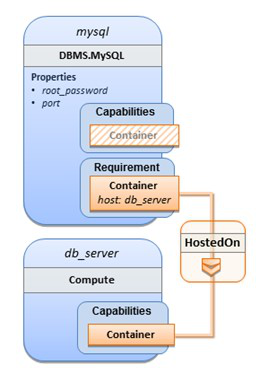

ONAP架构分析以及TOSCA模型简介
source link: https://www.sdnlab.com/22904.html
Go to the source link to view the article. You can view the picture content, updated content and better typesetting reading experience. If the link is broken, please click the button below to view the snapshot at that time.
作者简介:肖凯西,SDN以及网络重构研究,博客地址:https://blog.csdn.net/crystonesc
ONAP(开发网络自动化平台)是由原Linux基金会下两大MANO工作组Open-O与ECOMP合并而来,Open-O主要是由中国移动发起的项目,而ECOMP则是当年AT&T提出Domain 2.0转型时的落地项目。两个组织合并后,ONAP也陆续推出了阿姆斯特丹,北京以及卡萨布兰卡三个版本。ONAP相对于其它的开源MANO系统,提供了更多丰富的功能,收到较高的关注度。
1.ONAP架构及主要模块介绍
上图是ONAP Beijing的整体架构,可以看到,其相对ETSI给出的参考标准更加复杂,接下来对ONAP整体架构进行简单的介绍。ONAP由一系列子模块组成,主要由两大部分构成,SDC和RUN-TIME,下图是ONAP的总体功能流程示意图:
1、运营人员在SDC完成VNF的载入等管理,并完成NS的编排设计、测试等工作,最后通过上线流程将NS推送到RUN-TIME的SO模块,整个设计过程是基于TOSCA/YANG模型完成的。
2、SO模块主要负责NS的管理,并解析来自SDC的模型文件,对于网络部分,则交给SDN-C进行编排,对于VNF和应用,则交给VF-C和APPC管理。VF-C主要负责VNF的全生命周期的管理。
3、SO还会将设计模型注入到A&AI之中,并且根据之后资源使用的动态情况,实时调整A&AI的资源使用情况。
4、最后,DCAE主要负责采集底层资源、应用、VNF、网络等状态数据,并提供大数据分析和闭环操作的能力。
1.1Design-Time(SDC)
Design-Time 是供开发,设计,测试人员对VSP(虚拟服务产品)进行设计的功能模块,对于开发人员,可以通过SDC对VNF进行开发和测试,对于设计人员,可以通过SDC将成熟的第三方VNF产品或者ONAP market place的VNF产品进行导入并验证,最后通过将不同的VNF组合起来,完成VSP的设计。对于测试人员,在设计人员完成VSP设计后,可以通过与SDC集成的测试环境来对VSP的功能,结构等进行验证,验证通过后,设计人员可以将VSP发布到Run-Time环境。上述的过程可以通过SDC GUI界面完成,同时也可以通过调用Rest API进行。
1.2Run-Time
在SDC中完成VSP设计后,设计人员可以将VSP发布到Run-Time环境中,可以理解,Run-Time实际生产环境,Run-Time中包含许多功能组件,以下进行详细说明:
1.A&AI(Active & Available Inventory)
A&AI的作用是维护资源(Resource)和服务(Service)的实时关系,其中资源(Resource)是指如CPU,存储,网络连接,VNF之类的构成服务的元素,而服务(Service)是由多个资源组合起来的。如下图所示,在设计人员完成VSP设计后,在向Run-Time发布VSP后,SDC会将VSP的模型载入AAI,AAI解析模型配置文件,将其中各类资源和服务的关系通过图的方式存储起来,举个例子,subscriber(服务订阅者,一般指客户) → NS(网络服务) → VNFs → VMs → compute/storage/networking nodes。之后在网络服务运行过程中,如果发生了动态的调整,其它组件也会通过接口将实时变化的信息反馈到AAI当中,综上所述,可以将A&AI看成一个动态的资源管理库。
2.SDN-C
SDN-C是ONAP中网络控制的核心,它可以通过Network Adapters与各类虚拟环境中本地的控制器或者网络组件交互,同时MSO可以通过API将网络开通,配置交给SDNC来处理。在SDN-C中最具体色的是提供DG-Builder,用户在通过DG-Builder来编写脚本,这些脚本包含一些一步一步执行的指令实践,例如:配置路由,发送BGP消息,发送Openflow消息等等,这些配置脚本可以通过SDN-C中的SLI来执行。DG-Builder能够使用户在不编写代码的情况下,为SDN-C增加新的功能。
3.APPC(Application Controller)
APPC对应到ETSI规范中,可以与VNFM对应,用于对VNF进行全生命周期的管理。
4.Multi-VIM/Cloud
在运营商的网络当中,虚拟化环境是由多厂家提供,例如:openstack,VMware等等,Multi-VIM/Cloud就是聚焦在这部分,如下图黄色的部分,Multi-VIM/Cloud在各类虚拟化环境和Run-time各模块之间提供了中间层,屏蔽了不同虚拟化环境的差异,提供统一标准的API,其中Provider Registry提供将基础虚拟化环境注册到A&AI的服务,包括虚拟化环境的地域,容量等等信息。Infra Resource提供给MSO,DCAE等组件管理资源的能力,例如创建VNF需要的虚拟机,SDN Overlay提供配置和管理虚拟化环境Overlay网络的功能,这些功能往往是通过虚拟化环境中本地的SDN controller来具体执行。VNF Resource LCM用于提供给APP-C和VF-C对VNF全生命周期的管理。由此可见,在ONAP中,已经考虑到了多VIM的集成,这非常符合运营商的实际情况。
5.MSO(Master Service Orchestrator)
MSO是ONAP的核心功能,当设计人员在SDC完成VSP的设计后,将VSP发布到Run-Time环境,此后如果由客户在OSS/BSS生成产品订单后,OSS/BSS通过调用MSO的接口,MSO就会将VSP进行实例化,MSO将VSP模型进行分解,关于网络这部分的开通需求交给SDN Controller(L1-L3),关于VNF APP这部分(L4-L7)的内容交给App Controllers处理,同时对于一些虚拟化的资源,则交给对应的云平台供应商,在这些底层组件完成开通后,会将结果反馈到MSO当中,同时MSO会将这些动态信息写入到AAI当中。
6.DCAE(Data Collection Analytics and Events)
DCAE是ONAP所宣称closed-loop的重要环节,如下图所示,DCAE纵向分为两个部分,DCAE Platform和DCAE Analytic Applications。DCAE Platform主要完成NFV环境的数据采集,并通过Data Movement模块对数据,实践,消息进行分发。这些结构化或者非结构化的数据可以持久化到其所称的data lake(数据湖当中),同时DCAE Platform还提供一系列数据的分析框架。DCAE Analytic Applications则是基于DCAE Platform的数据分析框架和采集数据开发的分析应用,用户可以根据DCAE的SDK开发自己相应的应用。同时DCAE还提供闭环反馈能力,当分析应用得出结果后,可以调用相关Action触发MSO,Controller对现网的网络服务进行调整。在部署上面,DCAE可以支持边缘和中心的分布式部署。
2.编排的核心:模型驱动
ONAP要完成对网络服务的编排和部署,其核心源于ONAP是按照模型驱动而设计的,设计人员完成VSP的模型设计,并提交给MSO编排器,MSO按照模型文件从资源到应用来对整个产品进行编排。为了完成编排,ONAP需要遵从一系列标准,其中TOSCA模型就是用于NS、VNF以及应用编排的。
TOSCA(Topology and Orchestration Specification for Cloud Applications)
TOSCA是云应用的拓扑编排规范,通俗的讲就是制定一个规范,用于描述应用在云平台上面的拓扑结构,目前支持XML和YAML两种格式。TOSCA目前被广泛应用到NFV的编排领域,其规范组织OASIS还给出了《TOSCA Simple Profile for Network Functions Virtualization (NFV) Version 1.0》,掌握TOSCA模型对理解ONAP的模型驱动有很大的帮助。下面通过《TOSCA Simple Profile in YAML Version 1.0》中的例子来简单介绍下TOSCA。
以下这个例子是如何使用TOSCA描述一个MYSQL数据库服务在云平台的部署信息:
1.定义基础资源服务器
tosca_definitions_version: tosca_simple_yaml_1_0
description: Template for deploying a single server with predefined properties.
topology_template: node_templates: my_server: type: tosca.nodes.Compute capabilities: # Host container properties host: properties: num_cpus: 1 disk_size: 10 GB mem_size: 4096 MB # Guest Operating System properties os: properties: # host Operating System image properties architecture: x86_64 type: linux distribution: rhel version: 6.5
上述TOSCA描述了一个简单的计算节点:my_server,其节点类型为tosca.nodes.Compute,当然这个类型是需要预先定义好元数据的,同时对my_server进行了capabilities(容量)和os(操作系统的描述),通过下图可以看出其描述结构:
2.定义输入输出
进一步,我们还可以对该TOSCA定义一些inputs和outputs,如上所示,inputs的作用是告诉编排器这里需要使用外部输入,这个外部输入会被应用到node_template的num_cpus当中,通过inputs的方式,用户可以自定义一些变量和参数。outputs的作用是告诉编排器暴露一些关于这个应用编排的状态信息。
3.安装mysql服务
如上所示,出现了一个新的节点mysql,并且类型属于tosca.nodes.DBMS.MySQL,同样tosca.nodes.DBMS.MySQL的元数据是预先定义好的,同样这里看到,对于这个mysql,需要用户输入其root密码以及端口,同时其需要(requirements)db_server作为部署主机。文件底部有对db_server的配置声明。如下图所示,是目前对TOSCA的图形描述。
4.配置数据库
如上所示,TOSCA还允许通过interfaces来定义一系列自动化的操作,对于本例子中的mysql,我们定义了一个脚本:my_own_configure.sh来对mysql进行配置。
5.数据库内容的部署
上面的定义都只是部署了一个mysql的应用服务,但是目前还没有创建database,上面的描述文件就能够告诉编排器创建一个节点名称为my_db的database,并且允许用户输入database的名称,用户名,密码以及端口。同时还可以看到在db_content部分定义了外部的数据表内容文件,用于导入数据。完成这部分定义后,一个完整的从数据库服务到数据库内容的部署就做好了,其关系如下图所示:
通过上面一个对MYSQL部署的示例可以看出,TOSCA模型能够清晰的描述出应用与资源之间的关系,同时还支持自动化操作,从而完成应用的配置和启动。
3.小结
本节首先对ONAP 北京版的功能架构进行了介绍,之后分析了ONAP模型驱动的核心TOSCA,之所以对ONAP进行研究,原因在于ONAP是目前开源MANO项目当中成熟度较高的,较ETSI提出的NFV参考架构还提供了许多其它功能,例如上面提到的SDC、A&AI等,并且这些功能特性都是从运营的角度来考虑的,对运营商OSS域的演进提供了很高的参考价值,目前运营商OSS域中的系统,例如:资源系统、智能网管、网络大数据平台等都能够在ONAP中找到对应的功能模块,这里不展开详细讲解。同时许多其它开源项目也将ONAP作为编排器纳入其架构中,例如Akranio项目中针对边缘计算的蓝图就将ONAP作为编排器,故希望通过本文简单介绍,能够让读者能够对ONAP有一个大致的认识。
参考资料:
1.https://wiki.onap.org/
2.《TOSCA Simple Profile in YAML Version 1.0》
Recommend
About Joyk
Aggregate valuable and interesting links.
Joyk means Joy of geeK


